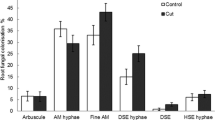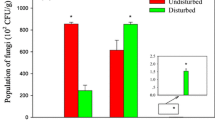Abstract
The effects of live and dead roots on soil fungi were investigated experimentally in a spodosolic soil of the New Jersey Pinelands. Field mesocosm plots were constructed to have a layer of either C- and N-rich organic soil or a vermiculite substitute overlying a layer of sandy mineral soil with a very low organic content. The plots were also supplied with live pitch pine and blueberry roots or dead pitch pine roots in varying quantities based on anturally occurring densities (half, same, and double the ambient quantities). All plots were sampled 1 year after construction (June 1991), and three more times in two subsequent years (November 1991, June 1992, June 1993). In the presence of live roots, fluorescein diacetate-determined (FDA-active) fungal hyphae, total fungal hyphae, and soil moisture decreased significantly in the organic material, while no change was associated with the dead roots. The FDA-active fungal length in the live-root plots ranged from 40 to 165 mg-1 soil, and from 55 to 335 mg-1 soil in the dead-root plots. While the total fungal length in live-root plots remained constant over time (∼3000 mg-1 soil), the total fungal length in the dead-root plots increased from an initial value of 3000 to >4000 mg-1 soil at the conclusion of the study. Fungal lengths in mineral soil were higher under organic material than under the vermiculite substitute. Soil moisture was higher in the presence of live roots in mineral soils, but this did not increase the fungal abundance. Inputs of dead roots did not alter the fungal abundance. Overall, we demonstrated that live and dead roots had different effects on fungal abundance in soils with contrasting qualities, and in a spodosolic forest soil, roots could have ecosystem effects very different from those in agricultural soils.
Similar content being viewed by others
References
Bottner P, Sallih Z, Billes G (1988) Root activity and carbon metabolism in soils. Biol Fertil Soils 7:71–78
Breland TA, Bakken LR (1991) Microbial growth and nitrogen immobilization in the root zone of barley (Hordeum vulgare L.), Italian ryegrass (Lolium multiflorum Lam.), and white clover (Trifolium repens L.). Biol. Fertil Soils 12:154–160
Cheng W, Coleman DC (1990) Effect of living roots on soil organic matter decomposition. Soil Biol Biochem 22:781–788
Clarholm M (1985) Interactions of bacteria, protozoa and plants leading to mineralization of soil nitrogen. Soil Biol Biochem 17:181–187
Cortez J, Cherqui A (1991) Plant growth and the mineralization of adsorbed 14C-and 15N-labelled organic compounds. Soil Biol Biochem 23:261–267
Curl EA, Truelove B (1986) The rhizosphere. Springer-Verlag, New York
Dighton J, Thomas ED, Latter PM (1987) Interactions between tree roots, mycorrhizas, a saprotrophic fungus and the decomposition of organic substrates in a microcosm. Biol Fertil Soils 4:145–150
Ehrenfeld JG, Kaldor E, Parmelee RW (1992) Vertical distribution of roots along a soil toposequence in New Jersey Pinelands. Can J For Res 22:1929–1936
Erland S, Söderström B (1990) Effects of liming on ectomycorrhizal fungi infecting Pinus sylvestris L. I. Mycorrbizal infection in limed humus in the laboratory and isolation of fungi from mycorrhizal roots. New Phytol 115:675–682
Erland S, Söderström B (1991) Effects of liming on ectomycorrhizal fungi infecting Pinus sylvestris L. III. Saprophytic growth and host plant infection at different pH values in unsterile humus. New Phytol 117:405–411
Faber JH, Verhoef HA (1991) Functional differences between closely related soil arthropods with respect to decomposition process in the presence or absence of pine tree roots. Soil Biol Biochem 23:15–23
Fisher FM, Gosz JR (1986a) Effects of trenching on soil processes and properties in a New Mexico mixed-conifer forest. Biol Fertil Soils 2:35–42
Fisher FM, Gosz JR (1986b) Effects of plants on net mineralization of nitrogen in forest soil microcosms. Biol Fertil Soils 2:43–50
Fogel R (1985) Roots as primary producers in below-ground ecosystems. In: Fitter AH, Atkinson D, Read DJ, Usher MB (eds) Ecological interactions in soil. Blackwell Scientific Publications, Oxford, pp 23–36
Fogel R, Hunt G (1983) Contribution of mycorrhizae and soil fungi to nutrient cycling in a Douglas-fir ecosystem. Can J For Res 13:219–232
Forman RTT (1979) Pine barrens: Ecosystem and landscape. Academic Press, New York
Frankland JC (1982) Biomass and nutrient cycling by decomposer basidiomycetes. In: Frankland JC, Hedger JN, Swift MJ (eds) Decomposer basidiomycetes: Their biology and ecology. Cambridge University Press, Cambridge, pp 241–261
Frankland JC, Harrison AF (1985) Mycorrhizal infection of Betula pendula and Acer pseudoplatanus: relationships with seedling growth and soil factors. New Phytol 101:133–151
Gadgil RL, Gadgil PD (1971) Mycorrhiza and litter decomposition. Nature 233:133
Gadgil RL, Gadgil PD (1975) Suppression of litter decomposition by mycorrhizal roots of Pinus radiata. NZJ For Sci 5:33–41
Griffin DH, (1981) Fungal physiology. Wiley and Sons, New York
Harmer R, Alexander IJ (1985) Effects of root exclusion on nitrogen transformations and decomposition processes in spruce humus. In: Fitter AH, Atkinson D, Read DJ, Usher MB (eds) Ecological interactions in soil. Blackwell Scientific Publications, Oxford, pp 267–277
Hendrick R, Pregitzer K (1992) The demography of fine roots in a northern hardwood forest. Ecology 73:1094–1105
Hendrickson OQ, Robinson JB (1984) Effects of roots and litter on mineralization processes in forest soil. Plant and Soil 80: 391–405
herbauts J (1980) Direct evidence of water-soluble organic matter leaching in brown earths and slightly podxolized soils. Plant and Soil 54:317–321
Hoaglin DC, Mosteller F, Tukey JW (1983) Understanding robust and exploratory data analysis. Wiley and Sons, New York
Holland EA, Coleman DC (1987) Littter placement effects on microbial and organic matter dynamics in an agroecosystem. Ecology 68:425–433
Ingham ER, Klein DA (1984) Soil fungi: relationships between hyphal activity and staining with fluorescein diacetate. Soil Biol Biochem 16:273–278
Jones PCT, Mollison JE (1948) A technique for the quantitative estimation of soil micro-organisms. J Gen Microbiol 2:54–69
Liljeroth E, van Veen JA, Miller HJ (1990) Assimilate translocation to the rhizosphere of two wheat lines and subsequent utilization by rhizosphere microorganisms at two soil nitrogen concentrations. Soil Biol Biochem 22:1015–1021
Markley ML (1971) Soil survey of Burlington County, New Jersey. USDA Soil Conservation Service, Somerset, NJ
Martin JK (1987) Effect on plants on the decomposition of 14C-labelled soil organic matter. Soil Biol Biochem 19:473–474
McClaugherty CA, Aber JD, Melillo JM (1982) The role of fine roots in the organic matter and nitrogen budgets of two forested ecosystems. Ecology 63:1481–1490
Merchx R, Dijkstra A, den Hartog A, van Veen JA (1987) Production of root-derived material and associated microbial growth in soil at different nutrient levels. Biol Fertil Soils 5:126–132
Moore JC, deRuiter PC (1991) Temporal and spatial heterogeneity of trophic interactions within below-ground food webs. Agric Ecosys Environ 34:371–397
Moore-Landecker E (1990) Fundamentals of the fungi, 3rd edn. Prentice-Hall, Englewood Cliffs, NJ
National Oceanic and Atmospheric Administration (1991) Climatological data annual summary, New Jersey 1990. National Climatic Data Center, Asheville, NC
National Oceanic and Atmospheric Administration (1992) Climatological data annual summary, New Jersey 1991. National Climatic Data Center, Asheville, NC
National Oceanic and Atmospheric Administration (1993) Climatological data annual summary, New Jersey 1992. National Climatic Data Center, Asheville, NC
Newell SY, Hicks RE (1982) Direct-count estimates of fungal and bacterial biovolume in dead leaves of smooth cordgrass (Spartina alterniflora Loisel.). Estuaries 5:246–260
Norton JM, Smith JL, Firestone MK (1990) Carbon flow in the rhizosphere of ponderosa pine seedlings. Soil Biol Biochem 22:449–456
Parmelee RW, Ehrenfeld JG, Tate RL III (1993) Effects of pine roots on microorganisms, soil fauna and nitrogen availability in two soil horizons of a coniferous forest spodosol. Biol Fertil Soils 15:113–119
parmelee RW, Ehrenfeld JG, Han X, Zhu W (1995) Effects of dead pine root inputs on soil fauna and the decomposition of dead roots in a spodosol soil from the New Fersey Pinelands. Acta Zool Fennica 196:27–32
Perry DA, Molina R, Amaranthus MP (1987) Mycorrhizae, mycorrhizospheres, and reforestation: current knowledge and research needs. Can J For Res 17:929–940
Poovarodom S, Tate III RL, Bloom RA (1988) Nitrogen mineralization rates of the acidic, xeric soils of the New Jersey Pinelands: Field rates. Soil Sci 145:257–263
Qualls RG, Haines BL (1991) Geochemistry of dissolved organic nutrients in water percolating through a forest ecosystem. Soil Sci Soc Am J 55:1112–1123
Qualls RG, Haines BL, Swank WT (1991) Fluxes of dissolved organic nutrients and humic substances in a deciduous forest. Ecology 72:254–266
Read JB, Goss MJ (1982) Suppression of decomposition of 14C labelled plant roots in the presence of living roots of maize and perennial ryegrass. J Soil Sci 33:387–395
Robinson D, Griffiths B, Ritz K, Wheatley R (1989) Root-induced mineralization: A theoretical analysis. Plant and Soil 117: 185–193
St John TV, Coleman DC, Reid CPP (1983) Growth and spatial distribution of nutrient-absorbing organs: selective exploitation of soil heterogeneity. Plant and Soil 71:487–493
Santantonio D, Grace JC (1987) Estimating fine-root production and turnover from biomass and decomposition data: A compartment-flow model. Can J For Res 17:900–908
Smucker AJM, Safir JR (1986) Root and soil microbial interactions which influence the availability of photoassimilate carbon to the rhizosphere. In: Mitchell MJ, Nakas JP (eds) Microfaunal and faunal interactions in natural and agro-ecosystems. Martinus Nijhoff/Dr W Junk, Dordrecht, pp 203–244
Söderström B (1977) Vital staining of fungi in pure cultures and in soil with fluorescein diacetate. Soil Biol Biochem 9:59–63
Tate RL III, Parmelee RW, Ehrenfeld JG, O'Reilly L (1991) Nitrogen mineralization: Root and microbial interactions in pitch pine microcosms. Soil Sci Soc Am J 55:1004–1008
Thomas A, Nicholas DP, Parkinson D (1965) Modifications of the agar film technique for assaying lengths of mycelium in soil. Nature 205:105
Vancura V (1988) Plant metabolites in soil. In: Vancura V, Kunc F (eds) Soil microbial associations: Control of structures and functions. Elsevier, New York, pp 57–144
Viereck LA, Dryness CT, Foote MJ (1993) An overview of the vegetation and soils of the floodplain eeosystems of the Tanana River, interior Alaska. Can J For Res 23:889–898
Vogt KA, Grier CC, Meier CE, Edmonds RL (1982) Mycorrhizal role in net primary production and nutrient cycling in Abies amabilis ecosystems in westen Washington. Ecology 63: 370–380
Vogt KA, Grier CC, Vogt DJ (1986) Production, turnover, and nutrient dynamics of above- and below-ground detritus of world forests. Adv Ecol Res 15:303–377
Vogt KA, Publicover DA, Vogt DJ (1991) A critique of the role of ectomycorrhizas in forest ecology. Agric Ecosyst Environ 35:171–190
Whipps JM (1990) Carbon economy. In: Lynch JM (ed) The rhizosphere. Wiley, New York, pp 59–97
Woodward JA, Bonett DG, Brecht ML (1990) Introduction to linear models and experimental design. Harcourt Brace Jovanovich, New York
Yavitt JB, Fahey TJ (1986) Litter decay and leaching from the forest floor in Pinus contorta (lodgepole pine) ecosystems J Ecol 74:525–545
Author information
Authors and Affiliations
Additional information
Contribution No. 94-29 from the Institute of Marine and Coastal Sciences
Rights and permissions
About this article
Cite this article
Zhu, W., Ehrenfeld, J.G., Parmelee, R.W. et al. The effects of live and dead roots on soil fungi in spodosolic soils of the New Jersey Pinelands. Biol Fertil Soils 21, 215–226 (1996). https://doi.org/10.1007/BF00335938
Received:
Issue Date:
DOI: https://doi.org/10.1007/BF00335938




